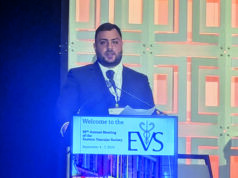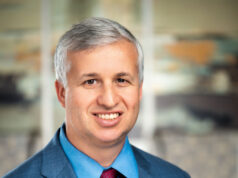
As was the case with the 2011 set, researchers hope the updated priorities will serve as a starting point to align research efforts within the Society for Vascular Surgery (SVS) and among vascular surgeons and scientists. This, in turn, will help drive larger investigations that lead to improved patient care.
For SVS and SVS Foundation awards, the stated priorities help the organizations determine what kind of studies should be considered. External organizations—such as the National Institutes of Health, the Veterans Administration and other organizations—also will know what SVS is looking to as important goals,” said the SVS Research Council’s Matthew Corriere, MD, who proposed updating the 2011 priorities.
Four of 2011’s nine priorities have been explored in national multicenter trials “that addressed the questions we posed,” said Edith Tzeng, MD, former chair of the SVS Research Council who orchestrated the current process to update the priorities. “Those original priorities provided some momentum in setting up trials. That helps drive the important message that, by listing priorities and putting them down on paper, it helps us as a Society and helps other researchers develop related trials. That’s our hope again—that’s the purpose of doing this,” she said of the update.
The four trials based on the initial research priorities are:
- Carotid Revascularization Endarterectomy versus Stenting-2 (CREST 2), seeking to define optimal management of asymptomatic carotid disease
- Best Endovascular versus Best Surgical Therapy in patients with critical limb ischemia (BEST-CLI) evaluating the effective of open versus endovascular treatment of CLI. This was ranked third in 2011 and results of the trial were just announced
- Non-Invasive Treatment of Abdominal Aortic Aneurysm Clinical Trial (N-TA3CT), to identify medical therapies for the prevention of the growth of abdominal aortic aneurysms (AAAs), specifically testing the ability of doxycycline to prevent AAA growth. Identifying and evaluating medical therapy to prevent AAA growth was ranked eighth in 2011. No clear benefit was demonstrated but “this trial represented the culmination of bench-to-bedside efforts of a number of SVS members working together to identify a medical therapy for AAA disease,” said the article
Finally, studies showed that ultrasound examination works for surveillance following endovascular AAA repair. That has been incorporated into recent SVS practice guidelines, and ultrasound surveillance has supplanted computed tomography angiography. Follow-up was the ninth priority in 2011.
“Our signature topics include aortic, carotid, and lower extremity vascular diseases,” Raul Guzman, MD, current chair of the Research Council, said. “Clinical trials would be very valuable in answering the big questions. We can invigorate and support research along the lines of our priorities now that we’ve stated what they are.”
The aim is stated in the Journal of Vascular Surgery. “It is our hope that, with the support of our partners in the National Institutes of Health, the American Heart Association, the Patient-Centered Outcomes Research Institute, the Veterans Administration, and other non-profit organizations such as Vascular Cures, we will continue to develop large-scale clinical trials and translational research efforts aimed at addressing many of these priorities. It is also our hope that these efforts will exceed the success of the inaugural set of research priorities, all for the betterment of our specialty and for the health of our patients.”
How the new priorities were created
The process of updating the nine Society for Vascular Surgery 2011 research priorities began in 2020, jump-started by SVS Clinical Research Committee Chair Matthew Corriere, MD, who noted that, after nine years, an update might be in order.
A total of 106 people involved in research were invited to answer an open-ended question: what are the “two most important questions that need to be answered in vascular research for the care of our patients?”
Those selected included the 2011 participants, SVS leadership, members of SVS Research Committees from 2019 to 2021 and members involved in vascular research. Sixty-six people responded with 134 questions, which were collected into topic areas. Lower extremity arterial disease was the focus of nearly 40 questions, followed by research methodologies, approximately 23; aortic disease, nearly 20; and carotid disease, approximately 17.
The council then identified 28 unique research priorities “of significant contemporary interest to the SVS membership,” including:
- Five for carotid disease
- Five, aortic disease
- Six, lower extremity arterial disease
- Four, venous disease
- Three, dialysis access
- Two, health care disparities
- Three, medical management of vascular disease
Participants convened for a virtual meeting in May 2021, where subject matter experts presented summaries of their topic areas, and focused on key knowledge gaps.
Attendees reviewed and discussed the topics and identified additional holes, creating a final list of 36 research questions to score. The list was distributed to the 28 stakeholders for voting, with 26 people—93%—responding and SVS administration tallying the results.
In the larger topic areas of carotid, aortic and lower extremity arterial disease, the top two priorities were selected. The top-scoring question in venous disease, dialysis access, health care disparities and medical management of venous disease made the list.
Gaining approval
The Research Council reviewed and approved the final 10 research priorities. The majority of those who responded to the request for research priorities were in the 40–49 and 50–59 age ranges, but the larger group did include both younger and older members. Most of the respondents were male, with 20% female representation.
This breakdown is similar to the demographics of the overall SVS membership, said Tzeng, former chair of the Research Council, and lead author of the article on the priorities in the Journal of Vascular Surgery.
The full breakdown by age and sex of respondents and SVS membership can be found in the article at vascular.org/ResearchPriorities. The council hopes to further diversify respondents for the next update on priorities, Tzeng added.
The Research Council recognized the SVS Executive Committee and SVS staff, particularly Sarah Murphy, senior director for research and education, who participated in the 2011 process and coordinated the updating effort, said Tzeng, Corriere and Guzman.












